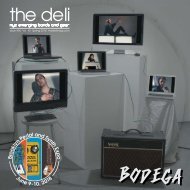You also want an ePaper? Increase the reach of your titles
YUMPU automatically turns print PDFs into web optimized ePapers that Google loves.
Housing <strong>The</strong> Struggle<br />
It’s impossible to discuss the New York City music scene<br />
without addressing the “900 dollars a month excluding<br />
utilities” elephant in the room: rent. At the crux of any environment<br />
in which young, broke musicians will thrive is<br />
the question of how they will afford to live there, and it’s a<br />
problem that NYC is notorious for, given the ever-increasing<br />
cost of living expenses for anybody who call the city<br />
home. Tangentially, when examining the city’s “It” neighborhoods<br />
throughout the years — the areas endowed<br />
with the ephemeral “cool factor” brought by the presence<br />
of artists — a pattern of eastward migration emerges, one<br />
coherent with the direction of NYC’s gentrification <strong>over</strong><br />
the last fifty years.<br />
As the city’s scene expands eastwards, as creative types<br />
settle into cramped three-bedroom Bushwick apartments<br />
en masse, the last bastion in <strong>Brooklyn</strong> appears on the<br />
precipice of full “artist-ification.” It makes sense why<br />
musicians, venue owners, and scenesters have begun<br />
looking eastwards, towards the inevitable jump to the<br />
Borough of <strong>Queens</strong>.<br />
Looking at the context of New York’s alternative scene<br />
since the 1960s helps illuminate why <strong>Queens</strong> is the heir<br />
apparent. <strong>The</strong> genesis of counterculture in Greenwich Village,<br />
its folksy cafe society of guitar-strapped drifters, the<br />
ilks of which included Bob Dylan and Simon & Garfunkel,<br />
provided a workable modus operandi that informs underground<br />
and DIY music in the city today; all that was necessary<br />
to host performances by up and coming musicians<br />
was a few microphones and a space that’s willing to open<br />
its doors to their admirers.<br />
Over time, such soundscapes inevitably became electric<br />
and the venues changed, moving towards the East River<br />
and into dives like CBGB and Max’s Kansas City, both of<br />
which played host to bands like <strong>The</strong> Velvet Underground,<br />
Ramones, and Talking Heads, purveyors of a distinct New<br />
York soundscape that was increasingly becoming darker,<br />
“weirder,” and more electronic. <strong>The</strong> next big transformation<br />
in alternative locale, however, wouldn’t occur until<br />
the early aughts, when the Lower East Side became the<br />
scene’s new “hot spot.” That, in tandem with the meteoric<br />
rise of then-young indie groups like <strong>The</strong> Strokes, Yeah<br />
Yeah Yeahs, TV on the Radio and Interpol, would anoint<br />
now-established performance spaces like the Bowery<br />
Ballroom, Mercury Lounge, Arlene’s Grocery and Pianos.<br />
As the LES thrived, concurrent development in the<br />
now-gentrifying <strong>Brooklyn</strong> would eventually push artists,<br />
bookers, and venue owners <strong>over</strong> the river, forming the<br />
basis of the two-borough New York scene we see today.<br />
A Tougher Enviromnent<br />
for DIY<br />
New York scenesters have developed some kind of refrain<br />
that’s reiterated when discussing (read: lamenting) a venue<br />
that’s on its way out: that when one space shuts down,<br />
another will inevitably pop up. We have come to accept<br />
that this reincarnation cycle will take shape in converted<br />
warehouses, multi-purpose spaces, and shabby bar/venue<br />
hybrids. But <strong>Brooklyn</strong>’s nightlife scene has faced heavy<br />
blows in the last few years. A combination of rising rents,<br />
creative leadership differences, and stringent building<br />
code restrictions have spurred a(nother) wave of closures.<br />
Within the last few years, <strong>Brooklyn</strong>’s had to say goodbye<br />
to DIY heavyweights like <strong>The</strong> Silent Barn, Shea Stadium,<br />
Palisades, and Aviv, among others that filled the<br />
void left behind by 285 Kent, Glasslands and Death By<br />
Audio’s closure. Most recently, the underground <strong>Brooklyn</strong><br />
club and anchor of <strong>Brooklyn</strong>’s techno scene, Output,<br />
announced that they would shut its doors come the new<br />
year. This comes just weeks after <strong>The</strong> Dreamhouse and<br />
<strong>The</strong> Gateway announced similar outcomes.<br />
<strong>The</strong>se setbacks may stem from serious concerns surrounding<br />
illegal DIY spaces, especially in the wake of the<br />
2016 Ghost Ship fire in Oakland, a tragic occurrence that<br />
claimed the lives of 36 people attending a house show<br />
at the artist collective space. While concerns surrounding<br />
fire safety and building codes are legitimate, many venues<br />
have faced disproportionate scrutiny from legislation<br />
surrounding nightlife (like the cabaret laws, which until<br />
recently banned dancing in venues) and city taskforces,<br />
such as the NYPD’s M.A.R.C.H. Taskforce, which targets<br />
community hotspots (as outlined by Liz Pelly in her piece<br />
in the Baffler, “Cut <strong>The</strong> Music”).<br />
the deli Winter <strong>2019</strong> 15







